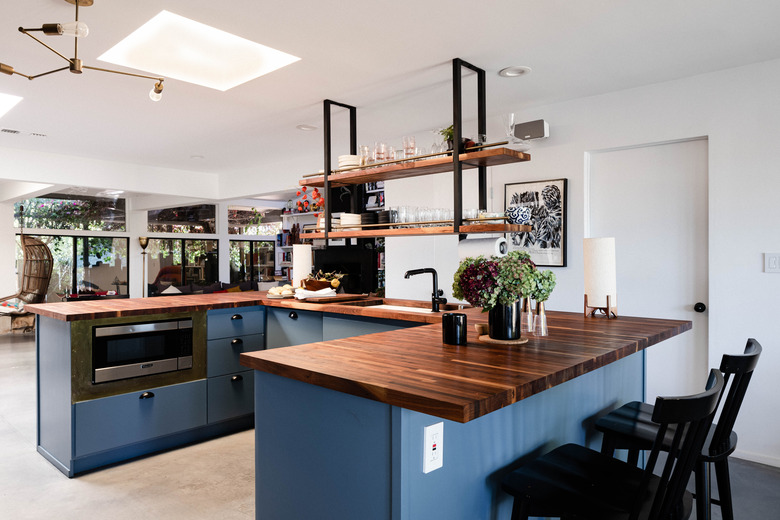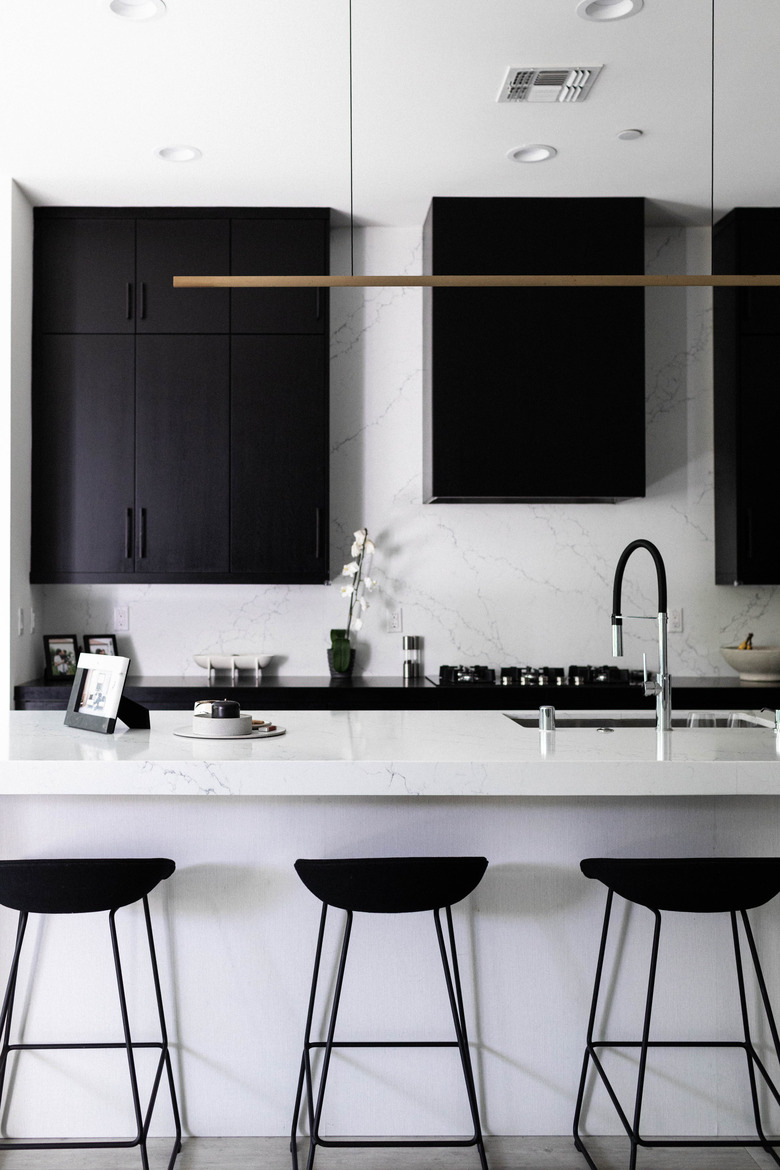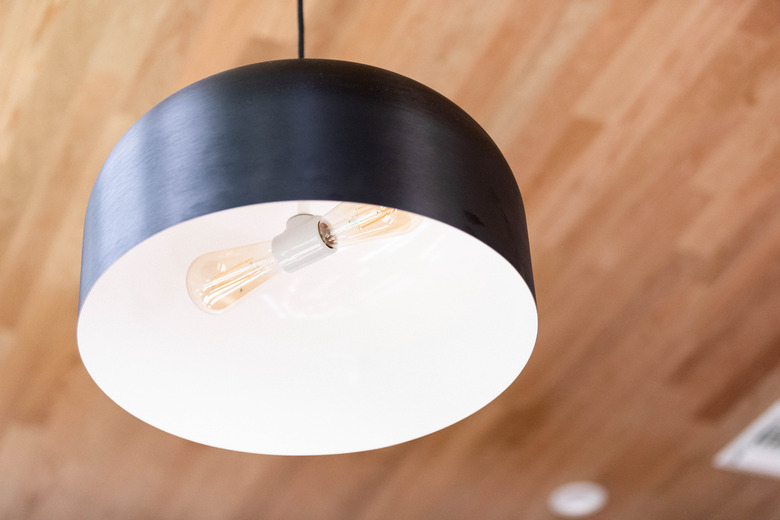What Is Kitchen Task Lighting?
Task lighting is unquestionably the workhorse of the kitchen. Ambient lighting allows you to easily navigate the room, and accent lights add charm, but it is task lighting on which you will rely when you have work to do. There are several different types of task lighting, but all strive to illuminate the workspaces and surfaces in your kitchen so that you are never working in a shadow.
Tip
Task lighting is simply a light fixture that illuminates a work surface and makes it easier for you to see details. It is important in the kitchen, but you likely have task lighting in other parts of your home as well, such as a reading lamp or desk light.
Task Lighting Basics
Task Lighting Basics
Task lighting is any light source you use to illuminate the space in which you are working, and it is something you probably use all the time without giving it a thought. If you switch on the light next to your favorite armchair so you can read, for example, you have used task lighting. You have also used task lighting if you have special bathroom lights you turn on when doing your makeup or trimming your beard.
Although there are exceptions, most ambient kitchen lighting comes from light fixtures mounted on or in the ceiling. These fixtures do a good job of lighting the center of the room but struggle to reach into corners. They are also positioned behind you when you stand at the counter along the edge of the room, and as such, you will cast a shadow onto your work surface that makes it harder to see. This is especially true of recessed lights, which shine down onto the top of your head rather than onto the countertop.
Task lighting solves these problems by providing an additional light source that shines right where you need it to shine. Ideally, task lights will sit between your head and your work surface. This will create the brightest illumination and will eliminate shadows. Getting rid of these shadows so you can see well is important. Shadows may make it inconvenient to, say, read a cookbook, but they can make it downright dangerous to cut vegetables with a sharp knife.
Where You Need Task Lights
Where You Need Task Lights
Your precise need for task lighting depends on how you use your kitchen. As a general rule, however, you should have task lighting over your stove, kitchen sink and countertops. If you have a kitchen island, you will likely want some task lighting above it as well. These are the obvious places, but there are a few more areas where task lighting comes in handy.
You can also make the kitchen a bit brighter by adding motion-sensor lights to your walk-in pantry or the shelves in your kitchen cabinets. It is convenient to have a light come on when you open a cabinet the same way it does when you open your refrigerator door. Some homeowners go so far as to install small lights in their kitchen drawers to make the contents easier to see.
These hidden lights serve a very utilitarian purpose, and because they are hidden away, they need not be fancy. Lighting these areas is about getting the job done rather than showing off your kitchen design. Still, your friends may coo a little when your silverware drawer lights up.
Task Lighting Fixtures
Task Lighting Fixtures
When it comes to task lighting, the most popular kitchen lighting option is under-cabinet lighting that shines down onto the countertops. Puck lights and LED light strips are most often installed. Both are available in easy-to-mount, battery-operated formats, but it is generally better to have an electrician hard-wire the lights for you. Otherwise, you will find yourself going through a lot of batteries. If you don't want to change light bulbs any more than batteries, the LED light strip is the best choice for you.
Use caution when choosing your under-cabinet lighting. As Angie's List points out, halogen bulbs and other bulbs that get hot work best under cabinets where you don't store food. When illuminating your counters, remember the island too. Kitchen islands are another common work area most often illuminated by pendant lights or another type of suspension lighting, which should generally hang about 30 to 36 inches above the island. Pendants also work well over sinks and stoves if you have the space to hang them.
Your choices are not limited to these options, however, and you can choose any task lighting that works for you and your kitchen. Over the stove, for instance, you may choose to install a vent hood with built-in lighting. You can also mount wall sconces if you like or hang a big chandelier over your kitchen table. Track lighting also works well since you can point it where you need it. Design rules are helpful, but the ultimate decision is yours to make.
Light Fixtures: Pulling Double Duty
Light Fixtures: Pulling Double Duty
When choosing your kitchen lighting fixtures, you may be able to ask certain light fixtures to pull double duty. Pendant lights hung over your kitchen island, for example, can serve as both task and ambient lighting if they are bright enough. The same is true of track lighting, which can shine onto workspaces and serve as accent lighting when pointed at a particular kitchen feature.
You can even get some extra work from your recessed lights. According to the Journal of Light Construction, recessed lights will cast some illumination on your kitchen countertop if you mount them between 18 and 24 inches from the wall. At 36 inches or more away, however, they will cast a shadow on the counter.
Task Lighting Tips and Tricks
Task Lighting Tips and Tricks
Experts often recommend placing task lights on a dimmer switch. Doing so allows you to turn up the brightness when you are working and turn it down when you want to create a more intimate setting. This allows your task lighting to pull double duty as accent lighting if you have a particularly attractive countertop or backsplash.
Keep in mind that the location of this dimmer switch is important. You want the switch for your ambient lighting placed near the kitchen entryway so you can turn it on as you walk into the room. You don't want the switch for your task lighting there, however, as this will force you to walk across the entire kitchen to turn it on. Instead, install the task light controls next to your sink, stove or countertop where they will be much more convenient.
Remodeling for the Future
Remodeling for the Future
When planning your kitchen lighting, think about how long you are likely to stay in your home. None of us are getting any younger, and our eyes change as we grow older. As your eyes age, your lenses tend to yellow and distort blue light. Your pupils also get smaller, letting less light in, and your eyes will start adjusting more slowly to changing light levels.
To combat this, pay attention to how many lumens your task lights provide. A lumen is a measure of light's brightness. When you are 20, you need about 400 lumens to work well at your kitchen counter. By the time you are 60, however, you will need 1,614 lumens to perform the same tasks in the same space. You can get more lumens by changing to a different light bulb, but make sure you never use a bulb that draws too much power (too high of wattage) for your light fixture.
Task Light Color
Task Light Color
While lumens measure the brightness of light, units called kelvin (K) are used to denote a light's color or temperature. The K scale works backward from what you might expect, with warm light appearing at the low end of the spectrum and cooler lights appearing at the high end of the scale. The yellow glow of a candle produces about 1,900 K, while the sun at high noon on a clear day produces 10,000 K.
When it comes to task lighting in your kitchen, the ideal temperature is around 4,100 K. Anything higher than that is usually considered too harsh for indoor use and can make being in the kitchen almost unpleasant. Going higher or lower can also distort the colors in your kitchen, with too many degrees kelvin producing a bluish light and too few a yellowish one. You can go warmer with your ambient light for a cozy feel, but keep your task lighting firmly in the middle of the scale.


